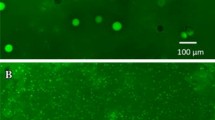Abstract
Lysozyme is used in cheese manufacture in order to prevent blowing in cheeses caused by Clostridium tyrobutyricum. Being an egg derivative, the presence of lysozyme must be included on the label for residual allergenic risk (2003/89/CE). The aim of this study was to evaluate the presence of lysozyme on proteic profiles of typical Italian cheeses such as Grana Padano through surface-enhanced laser desorption/ionization time-of-flight mass spectrometry. The proteolytic activity of ripening (from 0 to 24 months), confirmed by a decrease in casein, did not influence the intensity of lysozyme peaks. Furthermore, ripened Grana Padano cheese could be differentiated on mass profiling from immature Grana Padano by the presence of particular signals that are probably related to casein proteolysis.






Similar content being viewed by others
References
Boscaini E, Van Ruth S, Biasioli F, Gasperi F, Mark TD (2003) J Agric Food Chem 51:1782
de Roos AL, Walstra P, Geurts TJ (1998) Int Dairy J 8:324. doi:10.1016/S0958-6946(98)00053-3
Duan J, Park SI, Daeschel MA, Zhao Y (2007) J Food Sci 72:362. doi:10.1111/j.1750-3841.2007.00556.x
Fremont S, Kanny G, Nicolas JP, Moneret-Vautrin DA (1997) Allergy 52:224
Gaiaschi A, Beretta B, Poiesi C, Conti A, Giuffrida MG, Galli CL, Restani P (2000) J Dairy Sci 83:2733
Guerin-Dubiard C, Pasco M, Molle D, Desert C, Croguennec T, Nau F (2006) J Agric Food Chem 54:3901. doi:10.1021/jf0529969
Hincke MT, Gautronb J, Panheleux M, Garcia-Ruiz J, McKee MD, Nys Y (2000) Matrix Biol 19:443
Hoffman KM, Ho DG, Sampson HA (1997) J Allergy Clin Immunol 99:360. doi:10.1016/S0091-6749(97)70054-X
Iaconelli A, Fiorentini L, Bruschi S, Rossi F, Mingrone G, Piva G (2008) J Am Coll Nutr 27:326
Kjelkevik R, Edberg U, Yman IM (1997) Environ Toxicol Pharmacol 4:157. doi:10.1016/S1382-6689(97)10057-6
Moio L, Addeo F (1998) J Dairy Res 65:317. doi:10.1017/S0022029997002768
Pellegrino L, Tirelli A (2000) Int Dairy J 10:435. doi:10.1016/S0958-6946(00)00065-0
Perez-Calderon R, Gonzalo-Garijo MA, Lamilla-Yerga A, Mangas-Santos R, Moreno-Gaston I (2007) J Investig Allergol Clin Immunol 17:264
Pischetsrieder M, Baeuerlein R (2009) Chem Soc Rev 38:2600. doi:10.1039/b817898b
Sato R, Takeyama H, Tanaka T, Matsunaga T (2001) Appl Biochem Biotechnol 91:109
Scharfen EC, Mills DA, Maga EA (2006) J Dairy Sci 90:4084. doi:10.3168/jds.2006-808
Schneider N, Becker C-M, Pischetsrieder M (2010) J Chromatogr B 878:201. doi:10.1016/j.jchromb.2009.07.040
Sinigaglia M, Bevilacqua A, Corbo MR, Pati S, Del Nobile MA (2008) Int Dairy J 18:624. doi:10.1016/j.idairyj.2007.11.022
Yoshinori M, Yang M (2008) J Agric Food Chem 56:4874. doi:10.1021/jf8001153
Acknowledgments
The authors are grateful to Milano Ristorazione for the support during this research. The authors also thank Caseificio Zucchelli for preparing the experimental cheeses.
Author information
Authors and Affiliations
Corresponding author
Rights and permissions
About this article
Cite this article
Dragoni, I., Balzaretti, C., Rossini, S. et al. Detection of Hen Lysozyme on Proteic Profiles of Grana Padano Cheese through SELDI-TOF MS High-Throughput Technology during the Ripening Process. Food Anal. Methods 4, 233–239 (2011). https://doi.org/10.1007/s12161-010-9146-4
Received:
Accepted:
Published:
Issue Date:
DOI: https://doi.org/10.1007/s12161-010-9146-4




